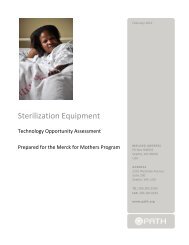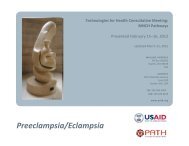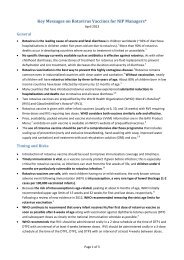Blood Loss Measurement - Path
Blood Loss Measurement - Path
Blood Loss Measurement - Path
You also want an ePaper? Increase the reach of your titles
YUMPU automatically turns print PDFs into web optimized ePapers that Google loves.
Spectrophotometric analysis can be performed by the methods described below: 13-151. Preparation of standard: 2 mL of peripheral blood are collected pre-delivery. The blood standard isprepared with 0.1 mL of the patient’s peripheral blood in 9.9 mL of 5% sodium hydroxide solution.The optical density (OD) is read at 550 nm after 30 minutes.2. Preparation of sample: The collected sample is added to 2 L of 5% sodium hydroxide and left to standfor 15 minutes. One mL of the filtrate is diluted 10 times in 5% sodium hydroxide and left to stand foranother 15 minutes. The OD is read with a spectrophotometer at 550 nm at 30 minutes after theaddition of sodium hydroxide to the sample.3. Calculations: OD sample × 2,000 mL × 10/OD blood standard × 100 = blood loss volume.Gap AnalysisCurrently, although there are no donors or projects with a $1 million investment in any of the abovementionedtechnologies, there are many key stakeholders involved in the process of implementing bloodloss measurement initiatives. These include patients, traditional birth attendants, health care providers,governments, funding sources, WHO, institutions specialized in research and implementation of methods,international and national nongovernmental organizations working in health fields, and manufacturers.WHO recommends that blood loss and other clinical parameters after childbirth should be closelymonitored. 16 According to WHO, there is insufficient evidence at present to recommend quantification ofblood loss over clinical estimation. Thus, WHO has identified the following priority research areas:Define the quantity of blood loss that should be the marker for diagnosis of PPH (blood loss greaterthan 500 mL) and severe PPH (blood loss greater than 1,000 mL).Determine the role of quantifying blood loss in altering (or improving) clinical outcomes for themother and her baby.Identify clinical consequences of blood loss that are of greatest value for the diagnosis and treatmentof PPH.Most of the technologies used to indirectly measure blood loss do not provide a real-time assessment orare difficult to implement in low-resource countries due to requirements for sophisticated laboratoryequipment.Among the quantitative technologies for blood loss measurement, the rubberized blood mat used inBangladesh is the most promising in terms of its simplicity, low cost, and capacity to identify PPH quickly,especially in home deliveries. The rubberized mat was acceptable and well liked in selected communitiesin Bangladesh. 164










